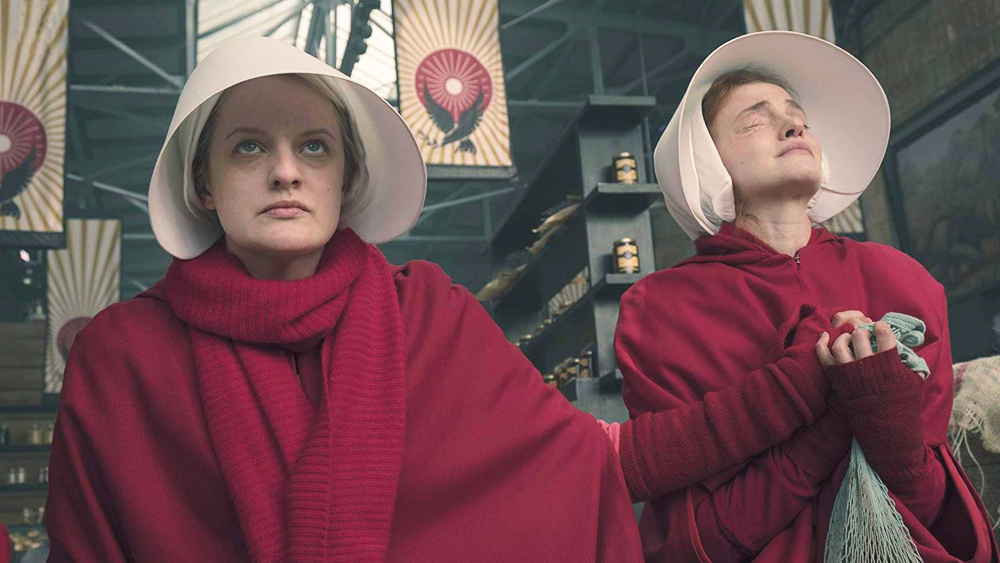Wading back into the murky depths of dystopian TV series The Handmaid’s Tale is like unearthing last winter’s wardrobe: it’s uncomfortable and disturbingly familiar.
This is not only because the recently released Season 3 continues to deliver the brutal twists and threatening silences we have come to expect in the warped dystopia of Gilead. But, more significantly, because the imagery and themes of this tale have become so ingrained in our culture.
Have we become numb to The Handmaid’s Tale or, at worst, amused by it?
When the Hulu TV series of The Handmaid’s Tale first launched in 2017, there was a collective gasp at the horrible abuse of women and terrifying picture of oppression it painted. Those in the Christian church were also confronted by the what many saw as a direct attack on their faith. Some were even more rocked by contemplating the possible kernels of truth on view. But as the shocks of seasons one and two wear off, perhaps the most disturbing aspect of The Handmaid’s Tale in 2019 is, in fact, its familiarity.
Flick through your social media feed and you’ll undoubtedly come across a red-robed, white-bonneted woman, a conversation spiked with terms like “blessed be” and a string of handmaid hashtags. Then there’s the tattoos.
“People — not only women — have sent me photographs of their bodies with phrases from The Handmaid’s Tale tattooed upon them, Nolite te bastardes carborundorum [Latin for “Don’t let the bastards grind you down”] and Are there any questions? [a comment from the novel’s epilogue] being the most frequent,” writes Margaret Atwood, author of the original novel upon which the TV series is based.
When Atwood’s book first hit the shelves in 1985, she says it was seen as “far-fetched”, with its construct of the United States as a religious dictatorship where women are forced into sexual servitude to relieve the society’s epidemic of infertility. That reaction was despite the fact Atwood based the book on elements of truth from history and culture, and did “not include anything that human beings had not already done in some other place or time, or for which the technology did not already exist.” Still, 30 years ago, the idea of such a society in our Western world seemed shocking and implausible.
Since then, the novel has taken on a life of its own. In 1990 it was made into a film, before it became an opera, ballet piece, theatre production and even a radio programme. The novel itself has been translated into more than 40 languages, and a graphic novel version has even been released. And since the launch of Hulu’s TV series, sales of the book have soared. In 2017 it was the most-read fiction of the year on Amazon’s charts, ahead of Harry Potter and Games of Thrones titles. The English language edition has now sold 8 million copies worldwide, according to Book Depository.
Many put the renewed enthusiasm for The Handmaid’s Tale down to the “Trump effect”. There’s been a multitude of comparisons – including by the cast of the series – between the pro-life movement in the US (supported by the US President) and the paternalistic control of women’s bodies in the TV series. Handmaids have become the mascot of the #MeToo movement and abortion rights campaigners, with red-hooded activists popping up at rallies all over the US (including Katy Perry, who used it at the MTV Awards).
But the adoption of the handmaid garb – which Atwood intended as a sign of oppression – has gone far beyond those making a political statement. It’s cropping up in YouTube comedy clips and as a theme for celebrity parties, such as the one Kylie Jenner threw for her bestie (which sparked a flurry of disgust on Twitter). Photos of babies in enlarged bonnets and models in handmaid inspired outfits are pasted all over Instagram.
Have we become numb to The Handmaid’s Tale or, at worst, amused by it? As it becomes commodified, absorbed and almost normalised, has this cautionary tale lost its edge, becoming more a cushion for entertainment than an instrument for change?
The spread of handmaid hysteria looks set to continue, with a sequel to the original novel – The Testaments – being launched by Atwood this September. It will be set 15 years after Offred’s final scene in The Handmaid’s Tale. To accompany the book launch, an interview with Atwood will be screened by National Theatre Live in 1,000 cinemas across the world (including here in Australia). No doubt, many of these will be filled with crimson-cloaked viewers.
For Atwood, The Handmaid’s Tale was meant to be a warning.
While The Handmaid’s Tale may be losing the sting of it’s message in our over-saturated culture, how should Christians continue to react to this series which is so anchored in loose elements of their faith?
Should they breathe a sigh of relief that the “heat is off”, thanks to the fading away of the serious conversations raised by the show about radical religiosity or the use of oppression in the name of God?
Perhaps they should just join with those bingeing the streamed series for pure entertainment. Or is the message that Atwood tried to communicate in her original novel particularly pointed for the global Christian community, parts of which can seem to stand dangerously close to the edge of Gilead?
If this is the case, then maybe it’s up to Christians to take the lead in reigniting the serious conversations.
For Atwood, The Handmaid’s Tale was meant to be a warning: “It’s one of those books you write if you think there’s a hole in the road up ahead. If you want people to fall into the hole in the road, you say nothing. If you want them not to fall into it, you say ‘There’s a great big hole in the road over there. Don’t fall into it.'”
So what would it look like for Christians to take this warning seriously? Could it mean deeper examination of attitudes towards women, identifying areas where more needs to be done to address the exploitation of women in Christian circles – and around the world?
Does this require the courage to face the ugliness of oppression within the ranks of Christianity – and outside?
Is it about becoming activists instead of remaining complacent and complicit?
Certainly, any deliberate response means revealing to our hurting world what true Christianity is actually based on: the grace, love and salvation of Jesus Christ.
Email This Story
Why not send this to a friend?



